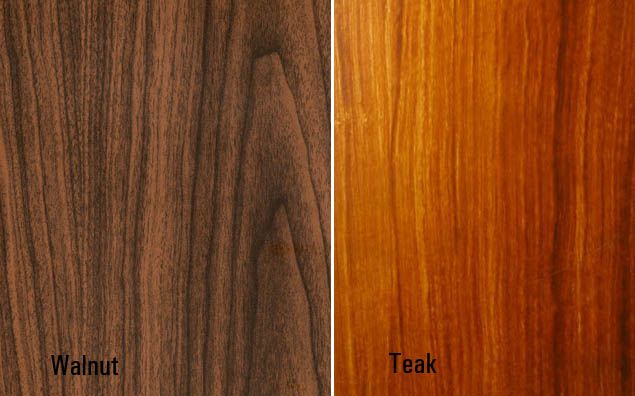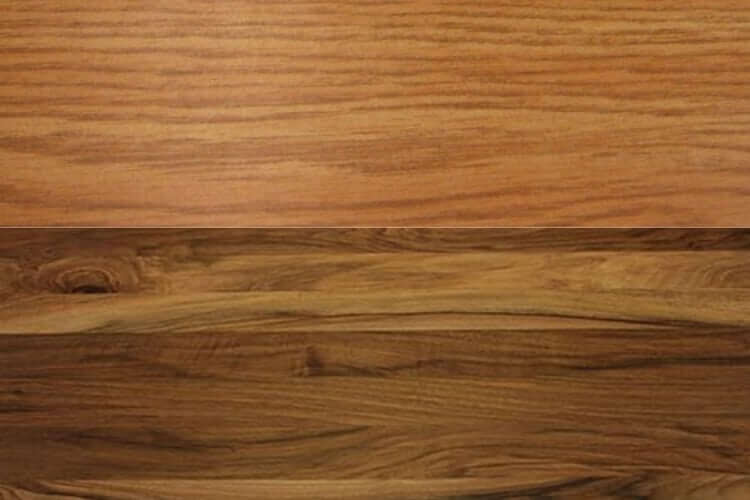Teak and walnut are two of the most popular hardwoods. Both provide quality, durable lumber and are extremely versatile.
You can use either of them to make fine furniture, cabinets, manufactured boards, including plywood and MDF, and many other items.
But what if you can only pick one? What if you have a cabinet-making project coming up and can only choose either teak or walnut, but not both? Which is the better pick? Read on to find out.
Teak vs Walnut: An Overview
Teak and walnut are both hardwoods. They are durable wood species. However, they have completely different backgrounds.
What is Teak Wood?
Teak is a dense, close-grained type of hardwood harvested from the Tectona grandis tree, native to the tropical regions of south and southeast Asia. It has a golden color, with a smooth grain and texture.
Teak trees naturally produce natural oils and rubber, making teak lumber strong, durable, and virtually impervious to extreme weather. If you’re looking to protect the wood and wonder, “Can I paint teak wood furniture?” the wood can last many years outdoors without the risk of rotting.
Unfortunately, teak wood is currently classified as an endangered species. Although it’s a sustainable plant, deforestation has threatened teak forests. As a result, teak wood can be a little pricey and even difficult to find.
Types of Teakwood
There are several dozen teak subspecies. However, the most common species, especially in the American and European markets, are;
- Burmese teak
- Indonesian teak
- Brazilian teak
- African teak
Teak Characteristics
It’s not easy to describe teak because the different subspecies vary in many ways. But, generally, you can identify teak wood by the following;
- Name: Teak (Tectona grandis)
- Color: The original teak wood color is Yellow-brown to dark golden brown heartwood and graying or white sapwood.
- Grain and Texture: Straight grain pattern with a coarse texture
- Physical properties: Teak is a moderately hard and heavy wood with low stiffness and shock resistance.
Pros and Cons of Teak Wood
Pros
- Durable
- Versatile
- Rot-resistant
- Natural beauty
- Easy maintenance
Cons
- It’s expensive
- Not easily available
Uses of Teak Wood
- High-class joinery
- Plywood and veneering (teak veneer)
- Indoor and outdoor furniture
- Cabinetry
- Flooring
- Paneling
What is Walnut Wood?
Walnut wood is lumber sawn from the Juglans genus. Its color and strength make it a popular wood species among woodworkers and in construction projects. Walnut is also an excellent wood choice for carving.
Walnut is typically a light brown to dark brown wood. However, the colors vary widely, from deep chocolate brown to purples and browns with reddish tints. The sapwood is typically blonde or yellow-gray.
Walnut is native to South and North America. Indeed, it’s the only brown wood native to North America. However, some species also grow naturally in South Europe and Asia.
Types of Walnut Wood
Walnut has more than a dozen subspecies. However, the most common types of walnut are as follows;
- Andrean walnut
- Black walnut
- Butternut
- Brazilian walnut
- English walnut
Characteristics
Though the exact characteristics vary depending on the walnut species, you can generally identify walnut lumber with the following;
- Name: Walnut (Juglans)
- Color: Chocolate brown
- Walnut Grain: Straight grain pattern, occasionally with curls and burls
- Physical properties: Walnut is a very strong wood (1700 Janka) with exceptional strength and bending properties.
Pros and Cons of Walnut
Pros
- Durable
- Water and mold resistant
- It’s a beautiful wood
- Extremely versatile
- Sustainable and eco-friendly
Cons
- It’s expensive
- Easily scratches
Uses of Walnut
Walnut is one of the best wood types for furniture making and cabinetry. The solid wood is also an excellent pick for carving. Anyway, the top applications include;
- Furniture
- Cabinets
- Flooring
- Gun stocks(see: best gun stock finishes)
- Paneling
- Veneers
Walnut vs Teak: Head to Head
So, you now know the individual characteristics of teak and walnut. Next up is a side-by-side comparison.

1. Appearance
Teak and walnut are almost similar in appearance. Both are brown wood types that tend to darken with age. However, walnut is a little darker, often chocolate brown. Also, both have straight grain patterns. However, teak has a tighter pattern with shorter grains.
Beware that stained teak can look like any premium wood. So, you want to be wary of dealers who sell pre-stained teak.
2. Durability
Teak is one of the heaviest hardwood trees, with some varieties weight up to 100 kg/m3. It is also incredibly durable due to the natural oils and rubber that make it extremely resistant t moisture and rotting. It is also highly resistant to insect attacks.
Walnut is almost as durable. However, a 641 to 689 kg/m3 density makes it a little lightweight compared to teak. Additionally, walnut becomes a lighter shade when exposed to sunlight, unlike teak, which naturally darkens with age.
3. Hardness
Both teak and walnut are hardwoods with exceptional strength. Indeed, they are almost equally hard, though teak is marginally harder.
The average teak lumber scores 1155 on the Janka scale, whereas a typical walnut wood piece scores 1010 on the same scale.
Remember that hardness directly impacts scratch resistance. Both types of wood are highly resistant to scratching.
Read also: Is cypress a hard or soft wood?
4. Strength
Bending strength, also known as the modulus of rapture, describes the maximum load the wood can bear parallel to the grain without capturing.
Teak and walnut are almost equally strong, with walnut just a tad stronger. Teak has a compressive strength of 41.1, while walnut scores 41.6 on the same scale.
5. Weather resistance
Both teak and walnut are weather resistant. However, teak is a lot more resistant to outdoor elements. In fact, one of the top qualities of teak furniture is that it can stand up to any weather, indoors or outdoors.
It contains natural oils that repel water, making it one of the most water-resistant woods. Walnut isn’t too far behind.
However, it’s spongy. Spong wood readily absorbs water. So, although it’s moisture resistant, walnut requires proper sealing to repel liquid water, such as raindrops.
6. Pest and insect resistance
Teak is highly pest and insect resistant. For example, it’s common knowledge that termites hate teak. The wood also resists beetles and borers. As a result, outdoor teak furniture can live for many years with insect damage.
Unfortunately, you cannot say the same about walnut. It’s a tree many insects love, from aphids to coding moths and walnut blister mites.
7. Sustainability
Both teak and walnut grow naturally and are sustainable. However, the forest area under walnut is bigger than that under teak. Indeed, many people consider it the ultimate alternative to tropical timbers.
Unfortunately, teak has suffered due to deforestation. The replacement rate is far slower than the depletion rate. Therefore, the wood is considered endangered.
8. Maintenance
Teak and walnut are both easy to finish and maintain. Weekly waxing is more than enough to keep the furniture in top shape. You can also easily clean teak and walnut wood with a damp cloth.
Always protect the furniture from water and consider treating the wood with pest repellants before adding the final finish for increased durability.
Here’s the best finish for walnut; whether you’re looking for a glossy or matte finish, we have something to suit your taste.
9. Teak vs Walnut Price
Both teak and walnut are expensive wood varieties due to their unique characteristics and demand. However, teak can cost 10-20-times more than walnut because of its rarity and higher demand.
You can always reduce overall costs by opting for veneer-covered MDF, though teak MDFs are still very costly.
You can read why is teak so expensive to learn more.
10. Uses
Finally, the uses of teak and walnut often overlap. Both types of wood are in high demand in the woodworking industry, where they are used in making wooden furniture, cabinets, wood masks, interior decorations, veneer, and musical instruments.
Here is also a comparison of cedar and redwood.
Teak and Walnut Alternatives
Many people use white oak, red oak, mahogany, and other woods where teak and walnut are unavailable or too expensive.
However, if you’re looking for like-for-like alternatives for Burmese teak, you can use FSC teak or Jatoba. Meanwhile, FSC and Andiroba are authentic-looking walnut substitutes.
Read Also: Oak Vs Walnut
Standout Features
What stands out about teak is its durability and rarity. Teak is exceptionally durable, capable of withstanding any weather conditions, especially high-moisture conditions. It is also highly pest and insect resistant.
Meanwhile, walnut stands out for its beauty and sustainability. In addition, walnut is pricy but more affordable than teak because it’s more readily available.
Next read: Is beech hardwood or softwood?
Walnut vs teak Verdict
Teak and walnut are two exceptional hardwoods with excellent physical and aesthetic qualities. However, they are also different in several ways.
- When to Use Teak Wood: We recommend using teak wood for outdoor and high-end items, such as fine furniture and musical items. It’s also the perfect choice for durable flooring and countertops.
- When to Use Walnut Wood: Walnut is a cheaper alternative to teak but with a bigger aesthetic appeal. So, it’s perfect for standard furniture, interior decor, cabinetry, and wood paneling.
All in all, both are good choices for woodworking. Just remember that teak is a lot more expensive than walnut, while walnut is more aesthetically appealing.

